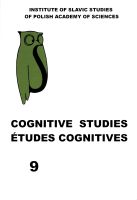Levels of Constructional Meaning: the Conuence of the Dative and Middle Voice in Polish and Croatian
Levels of Constructional Meaning: the Conuence of the Dative and Middle Voice in Polish and Croatian
Author(s): Barbara Kryżan-Stanojević , Mateusz-Milan StanojevićSubject(s): Language and Literature Studies
Published by: Instytut Slawistyki Polskiej Akademii Nauk
Keywords: dative; middle voice; grammaticalization; Croatian; Polish.
Summary/Abstract: In Croatian and Polish various constructions with the reflexive marker se / się may or may not involve a noun in the dative case. In Croatian one may say govori se o ovome problemu `this problem is discussed' as well as stalno im -DAT se govori o tom problemu `they are being told about this problem all the time'. Other examples include, for instance, Kto wie, co się zdarzy za dziewięć miesięcy (Polish) `Who knows what will happen in nine months' as opposed to {A jeżeli zdarzy im}-DAT się coś złego? `And what if something bad happens to them?'. In this paper we will discuss the way in which the se / się construction interacts with the dative case in the construction of meaning. A corpus study was conducted on the IPI PAN corpus of Polish http://korpus.pl/ and the Croatian National Corpus \ http://www.hnk.ffzg.hr to find examples where the se / się construction coincided with the dative construction. The results show that there are two basic semantic groups: the allative/competitor group and the transfer group, which partially corresponds to semantic groups found for various dative senses (Stanojević and Tuđman Vuković forthcoming). In the allative/competitor group the dative serves as an abstract goal, and the se / się construction marks the self-movement of the agent (i.e. the fact that it has internal energy). As opposed to that, in various transfer subsenses the se / się construction is grammaticalized to defocus the agent, and the dative gradually changes its role from a potentially affected recipient (as in stalno im - DAT se govori o tom problemu `they are being told about this problem all the time') to a completely affected experiencer Meni-DAT kad se plače plačem} `When I feel like crying I cry'; Wszystko można, tylko człowiekowi-}DAT się nie chce `Anything can be done, but a person simply doesn't feel like it'). In these senses both the dative and the se / się construction are grammaticalized in respect to their other senses, and are hence semantically bleached. Therefore, in those senses new constructional meaning occurs, which is not present in any senses of the two components taken alone: dative as the experiencer of its internal change of state. Constructional meaning is possible only in the bleached senses, which are less detailed in respect to the ``basic'', diachronically older senses.
Journal: Cognitive Studies | Études cognitives
- Issue Year: 2009
- Issue No: 9
- Page Range: 181-197
- Page Count: 17
- Language: English

